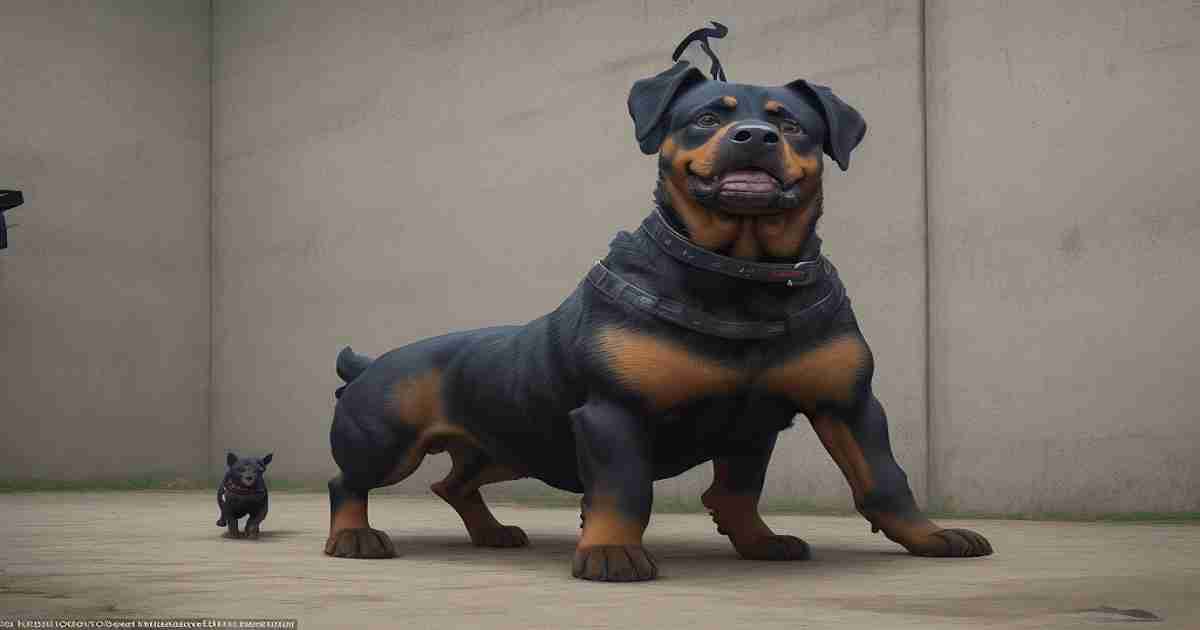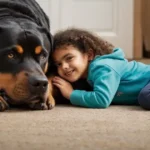The Russian Rottweiler is a relatively newer offshoot of the classic Rottweiler breed.
While sharing a common ancestry with Russian and German Rottweilers, have diverged in recent decades due to isolated breeding conditions and selection for enhanced size and cold weather adaptability.
It has produced some notable differences from the original German working lines.
Origins and History
- The origins of the Russian Rottweiler began after World War II when the Soviets occupying Germany brought back Rottweilers and other working dog breeds.
- These German dogs were bred with local Russian dogs, including Siberian breeds adapted to frigid temperatures.
- Intentional breeding in Russia focused on developing larger, more resilient Rottweilers capable of police and military work in extremely harsh conditions.
- The Russian Rottweiler remained isolated from other Rottweiler populations until the 1990s, after the Soviet Union collapsed.
- Today’s Russian breeders aim to maintain enhanced size and protectiveness while refining show champion traits.
Physical Features and Appearance
- Russian Rottweilers are significantly larger than German Rottweilers, with males reaching over 130 pounds compared to the German standard of 110-130 pounds.
- They tend to be taller with longer legs, more angulation, and more of a wedge-shaped head compared to the blockier head of German Rottweilers.
- The coat is thick and dense, with intense black coloring and vivid rust markings.
- Russian Rottweilers move with a light-footed trot covering more ground than a German Rottweiler’s steady trot.
- Blue or extremely light eyes are sometimes seen in Russian Rottweilers, unlike the rich dark brown eyes prized in German Rottweilers.
About the German Rottweiler:
German Rottweiler: A Legendary Heritage
The German Rottweiler represents the original type developed in Rottweil, Germany, centuries ago.
Their history is deeply rooted as tough cattle dogs and butchers’ assistants. Modern German Rottweilers remain closely tied to their working heritage and versatile talents.
Historical Background and Evolution
- Rottweilers are named after Rottweil, Germany, where they were used to herd livestock and pull butcher’s carts to market.
- Selective breeding focused on strength, endurance, and protectiveness to produce excellent working dogs.
- Even as demand for their services declined, dedicated German breeders maintained and preserved rare old bloodlines.
- Today’s German Rottweiler has changed little from its working origins and exemplifies desired breed traits.
Physical Characteristics and Build
- German Rottweilers have substantial bone structure and powerful muscling in a medium-large build.
- Males range from 95 to 130 pounds, and females 77 to 110 pounds per AKC standards.
- The compact, robust body is slightly longer than tall and features a broad skull with dark almond-shaped eyes.
- The short black coat has well-defined rich tan markings on the cheeks, muzzle, chest, and legs.
Comparing the physical differences between Russian and German Rottweilers:
Physical Differences
While Russian and German Rottweilers share a common foundation, their lineage has diverged, resulting in some notable physical differences.
Size and Proportions
- Russian Rottweilers are significantly taller and heavier than German Rottweilers.
- Russian males often exceed 130 pounds, while Germans range from 110-130 pounds.
- Russian females weigh 80-100 pounds compared to 60-85 pounds for German females.
- Russians have a leggier build and stand 2-3 inches taller than German Rottweilers.
Head Structure and Features
- Russian Rottweilers have longer muzzles, more stop (forehead indentation), and a wedge-shaped head.
- German Rottweilers have broader, blockier heads with fuller, almond-shaped eyes.
- Ears are higher on a Russian Rottweiler than the German variety.
Body and Muscularity
- Russian Rottweilers possess more angulation of the hindquarters resulting in a leggier outline.
- German Rottweilers have a squarer, stockier, and more powerful physique ideal for drafting work.
- Both types exhibit substantial bone girth and well-developed muscling.
Temperament and personality trait differences between Russian and German Rottweilers:
Temperament and Personality Traits
While Russian and German Rottweilers share common breed traits, their distinct backgrounds have also shaped some differences in temperament.
Loyalty and Devotion
- Both Russian and German Rottweilers form intensely loyal bonds with their owners and are eager to please.
- Russians may be more aloof with strangers compared to the outgoing friendliness of German Rottweilers.
Protective Instincts
- Russians tend to be more suspicious and wary due to their exclusively protective lineage.
- German Rottweilers have strong guarding instincts but are less intense without herding influence.
Socialization and Behavior
- Extensive early socialization helps Russian Rottweilers adjust to strangers and new situations.
- German Rottweilers take more naturally to socialization but still require exposure for balanced behavior.
Trainability and Obedience
- Germans are known for their trainability and obedience thanks to their working dog heritage.
- Russian Rottweilers may be more strong-willed and require consistent handling and firm leadership.
Training and intelligence differences between Russian and German Rottweilers:
Training and Intelligence
Both types of Rottweiler are highly intelligent and respond best to dedicated training. However, there are some differences in their learning styles.
Learning Capabilities and Adaptability
- German Rottweilers tend to be more biddable and eager to please, making training more straightforward.
- Russian Rottweilers can be more independent thinkers requiring creative motivation and engagement tactics.
Effective Training Approaches
- Positive reinforcement training is highly effective for both varieties, using rewards to shape desired behaviors.
- German Rottweilers readily accept this method, while Russians may need extra consistency and firm leadership.
Social Training and Exposure
- Germans tend to accept socialization more naturally but still require proper exposure.
- Extensive socialization starting in puppyhood is essential for Russian Rottweilers.
Problem-Solving Abilities
- The working heritage of German Rottweilers makes them exceptionally responsive to obedience and task training.
- Russian Rottweilers excel at protection work due to their wariness of strangers.
Let me know if you want me to expand on any aspect of this training comparison section before moving on. I’m happy to add more details as needed.
Exercise and activity differences between Russian and German Rottweilers:
Exercise and Activity Requirements
Both Russian and German Rottweilers require a lot of activity. However, Russians tend to have even higher exercise needs.
Physical Exercise Needs
- Russian Rottweilers demand extensive daily exercise to prevent boredom and unwanted behaviors.
- German Rottweilers have high exercise needs but are generally satisfied with traditional activity levels for the breed.
Mental Stimulation and Engagement
- Interactive play, obedience training, and puzzle toys help meet the needs of both breeds.
- Russian Rottweilers thrive when given demanding tasks and jobs to challenge their intellect.
Outdoor Activities and Games
- German Rottweilers enjoy activities like hiking, swimming, and fetching.
- Russian Rottweilers excel at intense activities like running, agility, and weight pulling.
Exercise Duration and Intensity
- Russian Rottweilers require at least 60-90 minutes of hard exercise daily.
- German Rottweilers need around 60 minutes of vigorous activity but less intense.
Grooming differences between Russian and German Rottweilers:
Grooming Needs
Russian and German Rottweilers have similar grooming requirements, though the Russian coat may need more attention.
Coat Care and Maintenance
- Both have a double-layered coat that sheds moderately year-round.
- The longer, denser coat of the Russian Rottweiler requires more frequent brushing to control loose hair.
Brushing and Shedding
- German Rottweilers need brushing 1-2 times weekly to manage shedding.
- Russian Rottweilers often need daily brushing during peak shedding seasons.
Bathing and Hygiene
- Bathing every 6-8 weeks is suitable for both varieties.
- Pay extra attention to facial folds and skin creases in Russian Rottweilers where dirt can collect.
Nail Trimming and Paw Care
- Nails should be trimmed every 2-3 weeks for both types.
- Larger nails on Russian Rottweilers must be carefully monitored.
Ear and Dental Care
- Clean ears weekly and brush teeth 2-3 times per week for optimal health of both varieties.
Health considerations between Russian and German Rottweilers:
Health Considerations
Russian and German Rottweilers are prone to similar health issues, though their differing size may impact some joint conditions.
Common Health Issues
- Conditions like hip and elbow dysplasia can affect Rottweilers of both varieties.
- Larger size may predispose Russian Rottweilers to more joint problems.
Genetic Predispositions
- Hereditary conditions like von Willebrand’s disease, hypothyroidism, and cardiac issues impact both.
- Responsible breeders screen breeding dogs for these and other congenital disorders.
Health Monitoring and Regular Check-ups
- Annual vet exams, bloodwork, and diagnostic tests allow early detection of emerging issues.
- Large Russian Rottweilers may need earlier and more frequent joint and heart evaluations.
Diet and Nutrition
- High-quality diets support joint, heart, thyroid, and immune system health in both types.
- Rapidly growing Russian Rottweilers require careful nutritional management.
Exercise and Weight Management
- Avoid over exercising young Rottweilers until growth plates close around 18-24 months.
- Prevent obesity through portion control and regular exercise once mature in both varieties.
Living conditions for Russian vs. German Rottweilers:
Living Conditions: Which is Best?
Russian and German Rottweilers can thrive in various living situations with the right care and training. However, there are some differences in their adaptability.
Urban and Rural Environments
- German Rottweilers tend to adapt more to city or country living.
- Russian Rottweilers strongly prefer having access to large outdoor spaces to roam.
Space Requirements and Living Areas
- German Rottweilers can manage in apartments or smaller homes if properly exercised.
- Russian Rottweilers do best with a large, securely fenced yard and bigger living space.
Indoor and Outdoor Preferences
- German Rottweilers are content relaxing indoors if they get sufficient activity.
- Russian Rottweilers want continual outdoor access and don’t do well cooped up inside.
Climate and Temperature Considerations
- German Rottweilers handle a range of climates though they may prefer cooler conditions.
- Heat-sensitive Russian Rottweilers struggle in very hot weather.
Living with Families vs. Individuals
- German Rottweilers thrive when included in family activities.
- Russian Rottweilers tend to bond most closely with one owner.
Choosing the Right Rottweiler for You
Selecting the best Rottweiler to suit your lifestyle and experience level takes careful consideration. While Russian and German Rottweilers can make wonderful companions, key differences impact their match potential.
Identifying Personal Preferences
Before deciding between a Russian or German Rottweiler, reflect on your desire for this breed.
Is it primarily for companionship and family life? For personal protection or guard duties? For involvement in dog sports and competitions?
List your ideal traits and characteristics to determine which variety aligns more closely with your goals. This self-assessment helps provide focus when researching the two types.
Matching Lifestyle and Activity Levels
Your daily routine and habits majorly influence choosing between a Russian or German Rottweiler.
Those with very active lifestyles who want a high-energy jogging or hiking buddy may find the Russian Rottweiler’s intensity and endurance an ideal fit.
On the other hand, suburban families looking for an affectionate yet protective pet will likely have an easier time with a German Rottweiler based on their moderate exercise needs and trainability.
Consider your current activity level and schedule to decide which type has activity requirements more compatible with your home life. It helps set realistic expectations.
Understanding Specific Needs and Commitment
First-time Rottweiler owners should understand that the trainable German Rottweiler may be easier to handle with less experience. Their eagerness to please makes training more straightforward.
Those with backgrounds handling assertive guardian breeds will appreciate the strong-willed nature of the Russian Rottweiler and enjoy the challenge of channeling their energy productively. This breed thrives with extensive activity.
Be realistic about the time commitment involved in properly exercising, training, and socializing either variety. Rottweilers have high needs to prevent problem behaviors.
Interacting with Potential Rottweilers
Once you’ve decided between a Russian or German Rottweiler, spend time interacting with potential breeders’ dogs to get firsthand experience with their personalities.
Many reputable breeders will allow you to visit and arrange “meet and greets” with parent dogs and older puppies.
Observing temperament and behavior traits allows you to make the best match based on your interactions.
Be sure to ask about health certifications and pedigree lineage during breeder visits.
Breeder vs. Adoption Options
Working with responsible preservation breeders is the best option to get a purebred puppy of either variety.
Make sure OFA and AKC documentation is provided. If interested in an adult, consider checking with Rottweiler rescues, as both Russian and German Rottweilers sometimes need adoption.
Introducing Your Rottweiler to Other Pets
Bringing home a new Rottweiler when you already have other pets takes careful preparation and slow introductions.
Given proper supervision and training, Russian and German Rottweilers can co-exist peacefully with cats, dogs, and other companion animals.
Preparation and Early Socialization
Start socializing your Rottweiler with other pets as early as possible. Attend puppy classes where they can interact positively with various animals in a controlled setting. Discourage any roughhousing and reward calm, polite greetings.
If adopting an adult Rottweiler, ask the rescue or previous owners about their exposure to different pets.
Socialization may need to be introduced more slowly depending on their past experiences.
Supervised Introductions
When introducing your new Rottweiler to a resident pet, do so on neutral territory like a park or training facility.
Keep both pets leashed as they sniff each other and get acquainted before bringing them together into a shared space.
Continually praise and reward friendly behavior between your Rottweiler and other animals. Have toys and treats on hand to associate the presence of other pets with good things.
Handling Different Pet Personalities
Confident resident pets may be quick to establish boundaries with an incoming Rottweiler. But timid animals require protective supervision so the Rottweiler does not overwhelm them.
Pet personalities may clash on occasion. Be prepared to separate them if tension arises. Allow them to co-exist calmly at a distance until any friction diminishes over time.
Maintaining a Peaceful Household
Even after initial introductions, your supervision remains essential whenever the pets interact. Pet-proof rooms where each animal can relax safely on their terms.
Set up a positive reinforcement training regimen for your Rottweiler to practice good manners around the other pets. Maintain structure and consistency in the household.
Addressing Potential Challenges
Territorial disputes, guarding behaviors, or prey-drive instincts can cause setbacks even after pets co-exist happily. Consult an animal behaviorist if problems persist beyond your efforts.
With time, patience, and proper training, Russian and German Rottweilers can integrate into homes with all kinds of pets. Their early socialization lays the foundation for harmonious bonds.
Raising Rottweilers with Children
Rottweilers can make wonderful family pets but need training and early socialization to interact safely and positively with kids. Supervision is always required, especially with younger children.
Rottweiler’s Natural Behavior with Kids
The Rottweiler’s herding background gives them an instinct to “parent” children. But their large size and boisterous energy can unintentionally intimidate or injure little ones. They see small children as playmates, not fragile beings requiring special care.
Without proper training, Rottweilers may use their mouth excessively during play with kids.
Teaching bite inhibition and setting boundaries is crucial for safety. Rottweilers should view the adults as authority figures over the children.
Teaching Children to Interact Safely
Parents must educate kids on safe behavior around Rottweilers before introducing a new dog into the home.
Children must move calmly, avoid grabbing fur/ears/tail, and avoid startling or tackling the dog in play.
Kids should be taught to respect the dog’s personal space and never approach when sleeping or eating.
Only touch and pet the Rottweiler when permitted by the adults. Screaming and roughhousing are prohibited.
Training Rottweilers for Child-Friendly Behavior
Use positive reinforcement to teach your Rottweiler commands like “leave it” and “settle” when around children.
Practice having kids handle ears, paws, and muzzle so the dog stays relaxed. Reward gentle play and calm interactions.
Puppies benefit from early socialization at “Family Dog” classes, where controlled exposure and training help promote safe kid/dog skills on both ends of the leash.
Superior Supervision and Interaction Rules
Children under ten should never be left alone unsupervised with a Rottweiler, even child-friendly ones.
Dogs see running kids as an invitation to chase. Always separate when play escalates.
Crate train your Rottweiler to take scheduled time-outs when kids have friends over.
Teach children to provide dog food, walks, and age-appropriate exercise under adult guidance. It strengthens the bond.
Benefits of Rottweilers as Family Pets
Rottweilers who learn to interact gently with kids make incredibly affectionate and patient companions.
They become attuned to children’s needs and learn to control their strengths. Proper training allows kids and Rotties to form trusting lifelong friendships.
Myths and Misconceptions
Despite their versatile talents, Rottweilers suffer many unfair stereotypes from inadequate training and care. Responsible ownership helps dispel these myths.
Aggressiveness Stereotypes
Rottweilers are often unjustly portrayed as inherently aggressive and dangerous. In truth, these dogs exhibit extreme loyalty, which, without proper training, can translate to overprotective behavior.
Early socialization greatly minimizes any wariness or reactivity.
Incompatibility with Children and Families
Many assume Rottweilers dislike children and threaten family life. On the contrary, these dogs desperately crave being part of the family.
With training, they learn to interact gently with kids. Supervision is still required, given their size.
Uncontrollable Temperament
The Rottweiler’s confident temperament is often mislabeled as unpredictable or vicious.
Consistent training and leadership are key to managing their strength and an occasional stubborn streak. Their intelligence makes them very responsive.
Guard Dog Misunderstandings
Rottweilers do have strong protective instincts. However, true guard dogs should discern real threats from non-issues.
Proper training teaches Rottweilers to look to their owner for direction rather than react impulsively to perceived dangers.
Breed-wide Behavior Generalizations
No entire breed inherently possesses the same personality and behaviors. Upbringing, training, genetics, and socialization influence temperament more than breed alone. Responsible Rottweiler owners help disprove exaggerations.
Rescuing a Rottweiler: What to Expect
Rottweilers given up by their owners often end up in shelters and rescues through no fault of their own. Adopting one of these deserving dogs takes patience but brings immense rewards.
Understanding the Rescued Rottweiler’s History
Try to learn your adopted Rottweiler’s background if possible. Were they strays struggling to survive?
Surrendered by a family unable to care for them? Abused or neglected? Their experiences, whether unknown or documented, influence their initial behavior.
Building Trust and Security
Rescued Rottweilers need time to settle into a stable home environment and learn to trust people again.
Let them adjust at their own pace rather than overwhelm them. Show them kindness, consistency, and patience.
Training and Rehabilitation
Most rescued Rottweilers benefit enormously from professional training to overcome lingering anxiety, fearfulness, or improper manners. Force-free positive reinforcement training boosts confidence.
Addressing Potential Behavioral Issues
Work with veterinary behaviorists and certified trainers if your adopted Rottweiler displays aggressive tendencies, extreme wariness, or other problematic behaviors resulting from past trauma.
Rewarding Experience of Rescuing
With understanding and compassion, adopted Rottweilers transform from shut-down, untrusting dogs into vibrant, loving pets who overcame hardships. They repay your patience with eternal devotion.
Conclusion
The Russian Rottweiler and German Rottweiler constitute two distinct lineages of this iconic breed, each with unique attributes.
Russian Rottweilers, bred isolated in frigid conditions, carry enhanced protective instincts and limitless endurance passed down from generations of police and military service. Their imposing presence and agility inspire awe.
German Rottweilers encompass centuries of versatile working dog abilities – herding livestock with tireless devotion and hauling heavy carts using brute strength. This heritage shines through in their trainability today.
While their origins and some traits differ, both Russian and German Rottweilers epitomize the courage, loyalty, and spirit that has defined this breed since its inception. They carry on the proud Rottweiler legacy through new generations of devoted owners.
With proper training, care, and respect for their exceptional abilities, Rottweilers continue proving themselves adaptable and multi-talented companions. Their steadfast guardian nature makes them a breed like no other, whether of Russian or German roots.
Frequently Asked Questions
Which is bigger, the Russian or the German Rottweiler?
- The Russian Rottweiler is significantly larger, with males reaching over 130 pounds compared to the 110-130 pound German. Russians also stand 2-3 inches taller on average.
Are Russian Rottweilers aggressive?
- They tend to be more protective than German Rottweilers. Early extensive socialization and training by an experienced owner help ensure a Russian Rottweiler lives comfortably with strangers and other pets.
Do Russian Rottweilers make good pets?
- Yes, with the right owner. Their size, exercise needs, wariness of strangers, and guardian instincts make them better suited for experienced singles or couples than families with small kids.
Are German or Russian Rottweilers healthier?
- With responsible breeding, both can be very healthy. Germans may have fewer joint issues simply due to their smaller size. Russians require extra supplementation to support their rapid growth.
Which type of Rottweiler lives longer?
- There is little difference in lifespan between the two; 10-12 years is average. Preventative care and avoiding obesity maximizes longevity for both Russian and German Rottweilers.














1 thought on “Magnificent 5 Crucial Differences Between Russian and German Rottweilers”